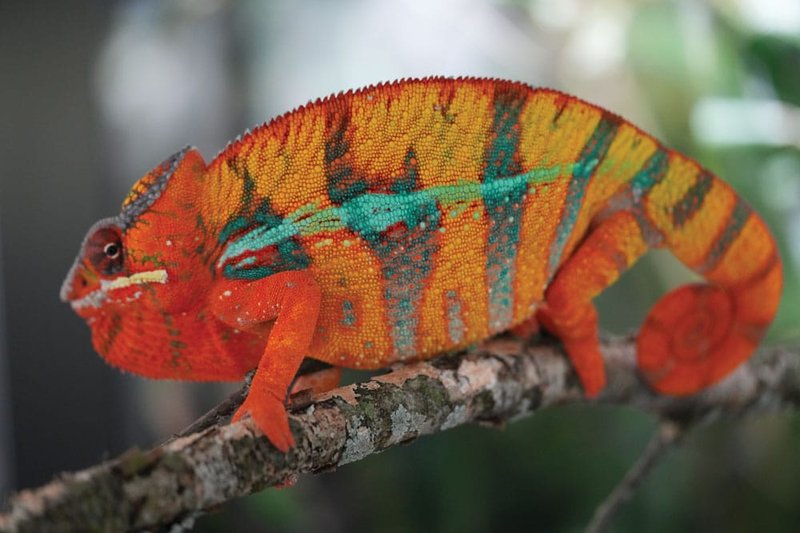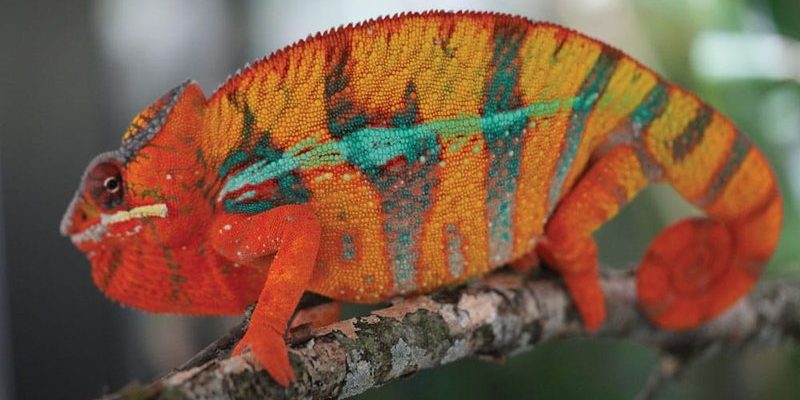
Imagine walking through the lush forests of Madagascar, where these chameleons call home. As you encounter one, you can’t help but marvel at its ability to change colors, a trait that has intrigued scientists and nature lovers alike. This vibrant display isn’t just for show; it plays a crucial role in their survival. So, let’s embark on a journey through time, exploring how the panther chameleon evolved into the stunning creature we see today.
Origins: Where It All Began
The story of the panther chameleon starts in Madagascar, an island that split from the African continent over 160 million years ago. This isolation allowed unique species to evolve, including our colorful friend. Chameleons, in general, are believed to have emerged around 100 million years ago, during the time of the dinosaurs. Paleontologists suggest that they share common ancestors with other lizards and have branched out into many species over time.
One fascinating aspect is the diversity of chameleons in Madagascar. The island’s various ecosystems—from rainforests to dry spiny forests—provided different habitats that shaped the development of the panther chameleon. These adaptations are not just about surviving; they have enabled the chameleons to thrive in a complex environment filled with challenges, such as predators and competition for resources.
The panther chameleon is thought to have evolved distinct traits that set it apart from other species. Not only do they have a unique color palette, but their ability to blend into their surroundings has allowed them to escape the eyes of potential threats. Their evolution is a wonderful example of natural selection in action, showing how species can adapt over time to ensure their survival.
A Colorful Adaptation: How Color Changes Work
One of the most captivating features of the panther chameleon is its ability to change color. You might think it’s all about being pretty, but it’s way deeper than that. These color changes serve specific purposes: communication, temperature regulation, and camouflage. You might be wondering how they actually do this.
Chameleons have special cells in their skin called chromatophores. These cells contain different pigments, and when the chameleon wants to change its color, it expands or contracts these cells. It’s like turning up or down the brightness on your screen, adjusting the colors to fit their mood or the environment. For example, males often display vibrant colors during courtship to attract females, while a subdued palette can signal submission or stress.
This color-changing ability is not just a fun party trick; it’s a survival tool. By blending into their surroundings, they can avoid predators or ambush prey. Just picture a panther chameleon perched on a branch, slowly shifting hues to match the leaves around it—what a clever strategy for staying safe!
Habitat and Distribution: A Home in the Trees
The panther chameleon’s habitat is primarily the tropical forests of Madagascar, where humidity and vegetation create an ideal living environment. They love to hang out in trees, using their long tails to balance while they hunt insects. The evolution of their specialized feet and prehensile tails has allowed them to navigate through branches with ease.
You might be curious about how they interact with their habitat. These chameleons are mainly arboreal, meaning they live in trees. Their coloration helps them blend in with the leaves, making them both hunters and hiders. They feast on a variety of insects, including crickets and mantises, showcasing an interesting aspect of the food web in their ecosystem.
However, habitat loss due to deforestation poses a serious threat to their survival. Madagascar has one of the highest rates of deforestation in the world, and as their natural habitats shrink, so too does their ability to thrive. This situation emphasizes the need for conservation efforts to protect these amazing reptiles and their home.
Unique Physical Traits: More Than Just Color
Aside from their remarkable color-changing abilities, the panther chameleon possesses several unique physical traits. For one, their eyes can move independently, which is fantastic for spotting prey or threats. Imagine being able to look in two different directions at once! This adaptation gives them a broad field of vision, enabling them to be aware of their surroundings without having to move their heads.
Additionally, they have a long, sticky tongue that can extend up to twice their body length. This tongue is a critical tool for capturing insects, letting them snag a meal effortlessly from a distance. The combination of their sharp vision and lightning-fast tongue makes these chameleons efficient hunters.
Their body shape also plays a role in their survival. The panther chameleon has a laterally compressed body, which helps them navigate through dense foliage. This shape, paired with their color-changing ability, ensures they can blend into their environment seamlessly or evade predators easily.
Reproduction and Lifespan: The Circle of Life
When it comes to reproduction, panther chameleons have a fascinating courtship ritual. Males usually display bright colors to woo females, showcasing their fitness and attractiveness. Once a female selects a mate, they will engage in a brief courtship dance, which can include head-bobbing and color displays.
After mating, the female lays eggs, with clutches ranging from 20 to 60 eggs, depending on her size and age. These eggs are buried in the ground to incubate, which can take several months. Here’s the thing: the young chameleons are born ready to fend for themselves—there’s no parental care involved. This independent start is common in many reptile species, where survival of the fittest takes precedence from day one.
In the wild, panther chameleons have a lifespan of about 5 to 7 years, although they can live longer in captivity with proper care. Their time on this Earth is a cycle of growth, adaptation, and survival—a true testament to the power of evolution.
The Importance of Conservation: Protecting the Panther Chameleon
As we’ve discussed, the panther chameleon is a remarkable species with a rich evolutionary history. Sadly, they face significant threats from habitat destruction and climate change. Conservation efforts are crucial in ensuring their survival for future generations. Protecting their natural habitats and raising awareness about their plight is essential.
Organizations dedicated to wildlife conservation are working hard to preserve the unique ecosystems of Madagascar. Engaging local communities in sustainable practices can help reduce deforestation and protect the habitats of these beautiful chameleons. You might be wondering how you can help; supporting conservation programs or adopting responsible pet ownership practices can make a difference.
Every step counts, whether it’s spreading the word or supporting initiatives that aim to protect these incredible creatures. By learning about the panther chameleon and its evolutionary journey, you can become an advocate for its future.
The evolutionary history of the panther chameleon is a captivating story of adaptation, survival, and beauty. From its unique origins in Madagascar to its mesmerizing ability to change colors, this species exemplifies the wonders of nature. Understanding how these fascinating reptiles evolved helps us appreciate not only their beauty but also the intricacies of their survival in a changing world.
As we continue to explore and study the panther chameleon, let’s remember the importance of protecting their habitats and ensuring their future. In a way, they remind us that evolution is an ongoing journey, one that we’re all a part of—whether we realize it or not.

